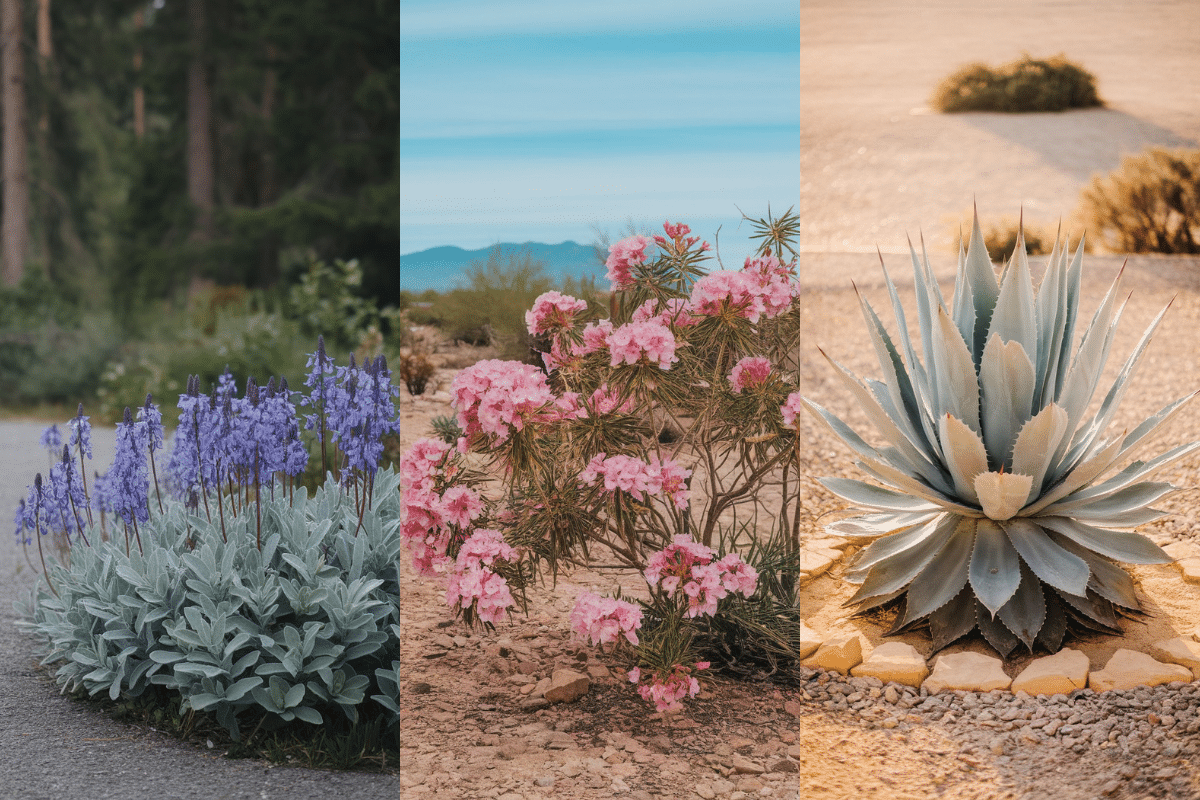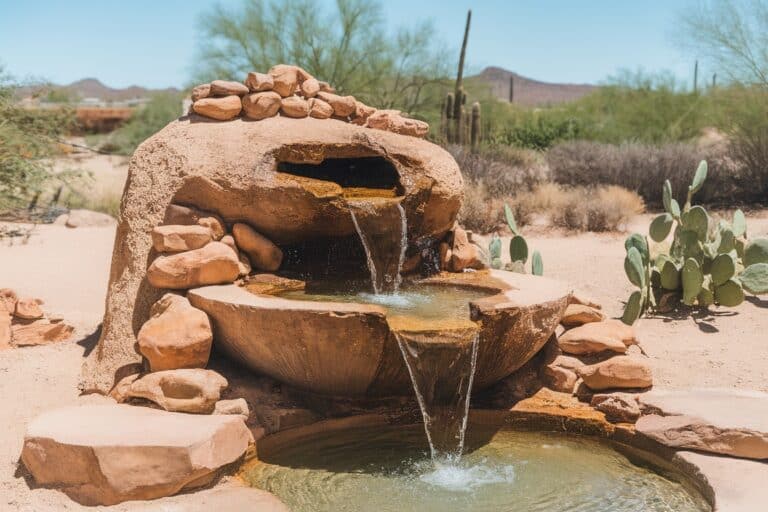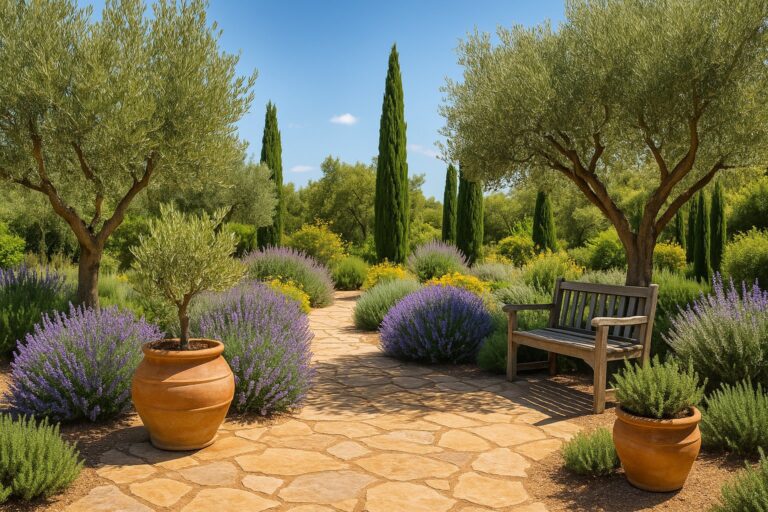12 Low-Water Plants to Revitalize Your Dry Garden
Is your garden struggling with dry conditions? You’re not alone! Luckily, there are plenty of low-water plants that thrive in arid environments. In this guide, we’ll explore 12 resilient options that can add color and vitality to your garden while keeping water usage to a minimum. Dive in and discover the perfect plants for transforming your dry space into a lively oasis!
Salvia nemorosa – Woodland Sage

Salvia nemorosa, commonly known as Woodland Sage, is a lovely addition to any dry garden. In the image, you can see clusters of vibrant purple flowers standing tall above soft silvery-green leaves. This plant not only looks beautiful but also thrives with minimal water, making it a great choice for those dry spots in your garden.
The flowers of Woodland Sage attract a variety of pollinators, such as bees and butterflies. This not only enhances the beauty of your garden but also supports local wildlife. The silvery foliage provides a nice contrast to the colorful blooms, adding texture to the landscape.
When planting Salvia nemorosa, consider placing it in a sunny spot with well-drained soil. It’s a hardy plant that requires little maintenance once established. This makes it perfect for busy gardeners or those looking to reduce their water usage.
In addition to its beauty and low water needs, Woodland Sage is also known for its resilience. It can handle drought conditions and still produce stunning flowers throughout the growing season. Incorporating this plant into your dry garden can create a lively and colorful atmosphere.
Echinacea purpurea – Purple Coneflower
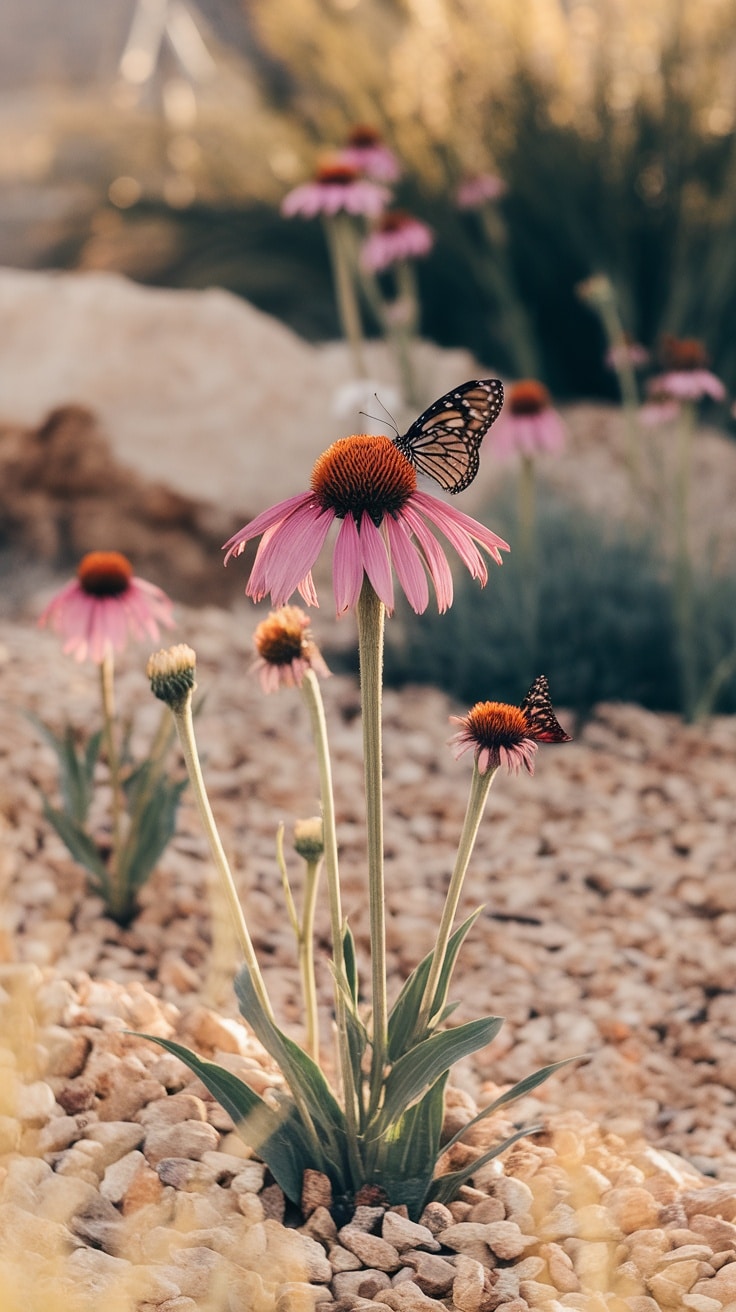
The Echinacea purpurea, commonly known as the Purple Coneflower, is a delightful addition to any dry garden. Its vibrant pink petals and distinctive cone-shaped center not only catch the eye but also attract beneficial pollinators like butterflies. In the image, you can see a butterfly perched gracefully on one of the flowers, showcasing how this plant can bring life and movement to your garden.
This hardy perennial thrives in well-drained soil and requires minimal watering once established, making it an excellent choice for those looking to conserve water. It prefers full sun but can tolerate some shade, adding versatility to your planting options.
Beyond its beauty, the Purple Coneflower has medicinal properties that have been appreciated in traditional herbal remedies. It’s known to support the immune system, making it a plant that not only brightens your space but also offers health benefits.
Yucca filamentosa – Adam’s Needle

Meet Yucca filamentosa, commonly known as Adam’s Needle. This plant stands out in dry gardens with its unique structure and striking flowers. The image showcases its sharp, spiky leaves, which grow in a rosette formation, giving it a distinct look. The tall flower stalk, adorned with delicate blooms, rises elegantly above the foliage, adding vertical interest to your garden.
Adam’s Needle thrives in low-water conditions, making it a perfect choice for gardens that experience drought. Its ability to withstand heat and poor soil is impressive. This resilient plant doesn’t just survive; it brings a touch of the exotic to your landscape.
When planting Yucca filamentosa, consider placing it among rocky landscapes or gravel beds. These settings mimic its natural habitat and enhance its aesthetic appeal. Plus, the combination of textures from the plant and the surrounding stones creates a visual feast.
Lavandula angustifolia – English Lavender
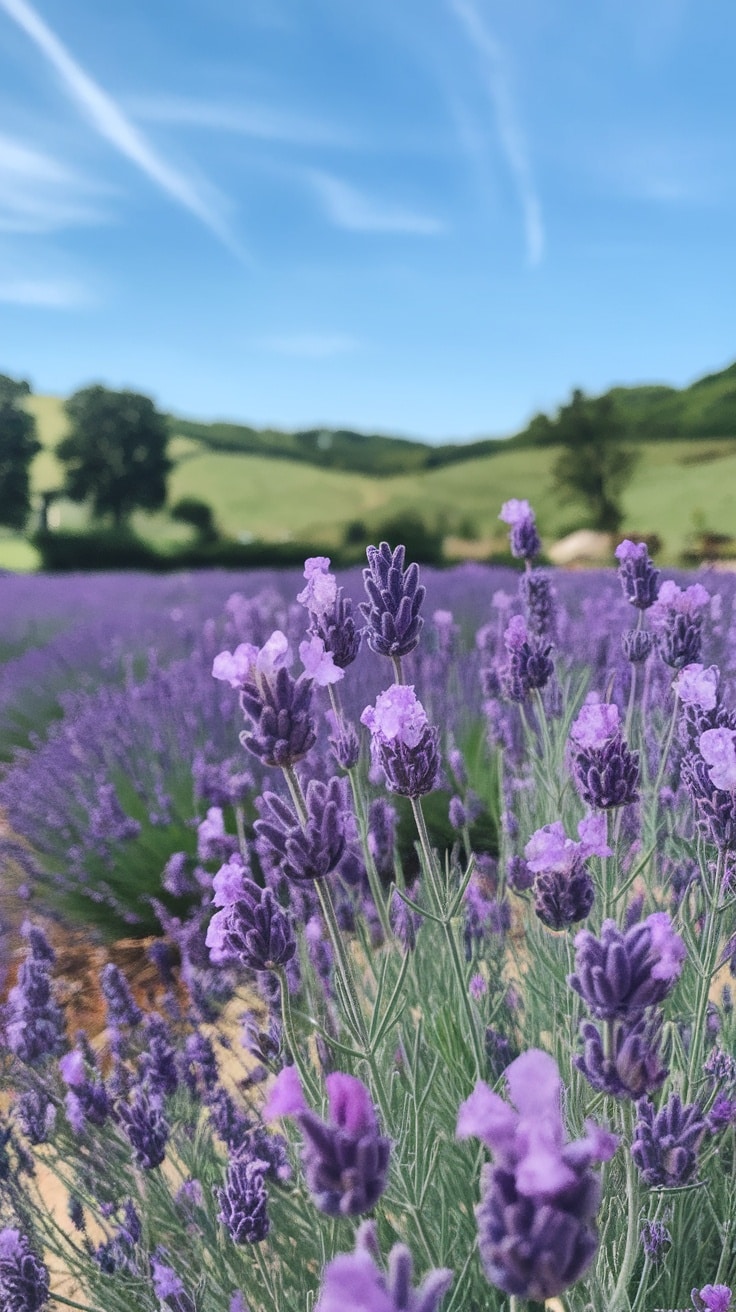
When you think of a dry garden, English Lavender (Lavandula angustifolia) immediately comes to mind. Its striking purple flowers stand tall against a backdrop of green, creating a visually pleasing contrast. This plant not only thrives in low-water conditions but also adds a pop of color to your landscape.
English Lavender is known for its delightful fragrance, which can fill your garden and home with a soothing aroma. It’s a favorite among gardeners who appreciate the calming effect of lavender. The compact, bushy form of this plant makes it an excellent choice for borders or pathways.
In terms of care, English Lavender is quite low-maintenance. It prefers well-drained soil and full sun, making it perfect for those hot summer days. Once established, it requires minimal watering, allowing you to enjoy a beautiful garden without the hassle of constant upkeep.
Additionally, this plant attracts beneficial pollinators like bees and butterflies, adding life to your garden. Whether you use it for culinary purposes, home fragrance, or simply to enhance your garden’s aesthetic, English Lavender is a versatile choice.
Dymondia margaretae – Silver Carpet

Dymondia margaretae, commonly known as Silver Carpet, is a charming ground cover that adds character to any dry garden. Its dense, low-growing foliage forms a lush, silver-green mat that can soften hardscapes beautifully. In the image, you can see how well it blends with the stone pathway, creating a seamless transition between hard and soft elements.
This plant is not just about looks; it’s also quite practical. Silver Carpet is drought-tolerant, which means it thrives in dry conditions with minimal water. This makes it a smart choice for those looking to conserve water in their gardens. The leaves are thick and slightly fuzzy, giving it a unique texture that contrasts nicely with smooth stones.
In terms of care, Silver Carpet is relatively low-maintenance. It prefers full sun and can tolerate light foot traffic, making it ideal for pathways or between stepping stones. Its ability to spread quickly can help suppress weeds, so it’s a win-win for gardeners. Incorporating this plant into your landscape can provide both beauty and functionality, making your garden both inviting and sustainable.
Agave americana – Agave Plant
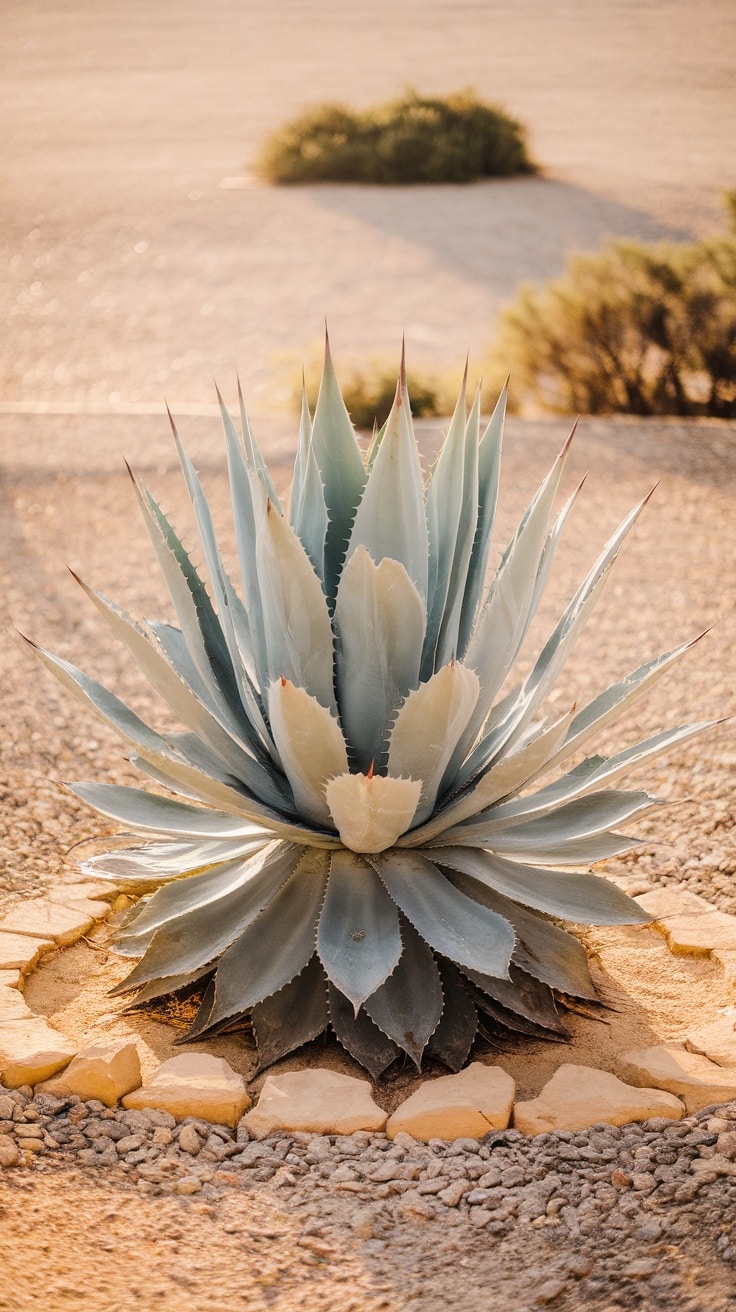
Agave americana, commonly known as the agave plant, is a striking addition to any dry garden. With its large, fleshy leaves that form a rosette shape, this plant stands out for its bold and architectural appearance. The blue-green color of its leaves adds a refreshing touch to the landscape, making it visually appealing.
In the image, you can see a prominent agave plant surrounded by gravel and other drought-tolerant plants. The combination of textures—from the sharp leaves of the agave to the round, spiky cacti nearby—creates an interesting visual contrast. This arrangement not only looks good but is practical for water conservation.
Agave americana thrives in sunny spots and requires minimal water once established. This makes it an excellent choice for those looking to transform their dry garden into a sustainable and low-maintenance space. Consider planting it alongside other low-water plants to create a cohesive look that celebrates the beauty of drought-resistant landscaping.
Aloe vera – Aloe
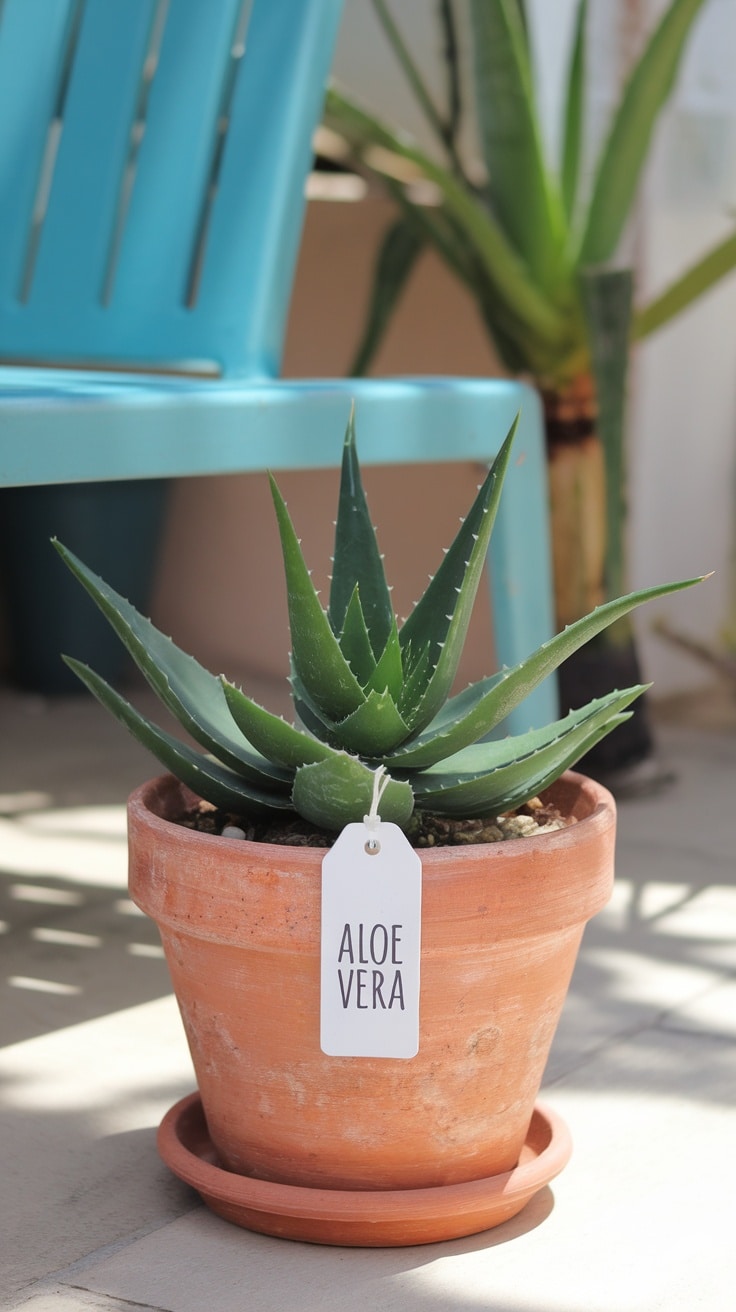
Aloe vera is not just a pretty plant; it’s a true survivor in dry conditions. This succulent thrives in low-water environments, making it a perfect choice for gardens that see little rain.
In the image, you can see a healthy Aloe vera plant in a classic terracotta pot. The pointed, green leaves are vibrant and show off the plant’s resilience. Aloe vera is often recognized for its medicinal properties, particularly in skincare. Its gel can soothe sunburns and moisturize dry skin.
Growing Aloe vera is easy. It needs well-draining soil and prefers bright, indirect sunlight. Water it sparingly, allowing the soil to dry out between waterings. This makes it an ideal companion for those who may forget to water their plants regularly.
Whether you want to use it for its health benefits or simply enjoy its beauty, Aloe vera is an attractive addition to any garden. Plus, it can thrive in a range of environments, from indoors to outdoors.
Sedum spectabile – Stonecrop

Sedum spectabile, commonly known as stonecrop, is a delightful addition to any dry garden. This plant thrives in low-water conditions, making it a perfect choice for those seeking low-maintenance greenery.
The image showcases the appealing arrangement of succulent leaves, which are a range of vibrant greens with hints of red edges. These fleshy leaves store water, helping the plant survive in arid environments.
During the blooming season, stonecrop bursts into life with clusters of pink flowers that add a splash of color to your garden. The delicate petals and sturdy stems create a lovely contrast against the rocky backdrop, enhancing the natural aesthetic.
One of the best features of Sedum spectabile is its ability to attract pollinators. Bees and butterflies love these flowers, making your garden a lively spot throughout the summer. Plus, the flowers can last for weeks, providing beauty well into the fall.
Incorporating stonecrop into your landscape not only beautifies it but also reduces the need for frequent watering. This makes it an eco-friendly option for gardeners looking to conserve water.
Nerium oleander – Oleander
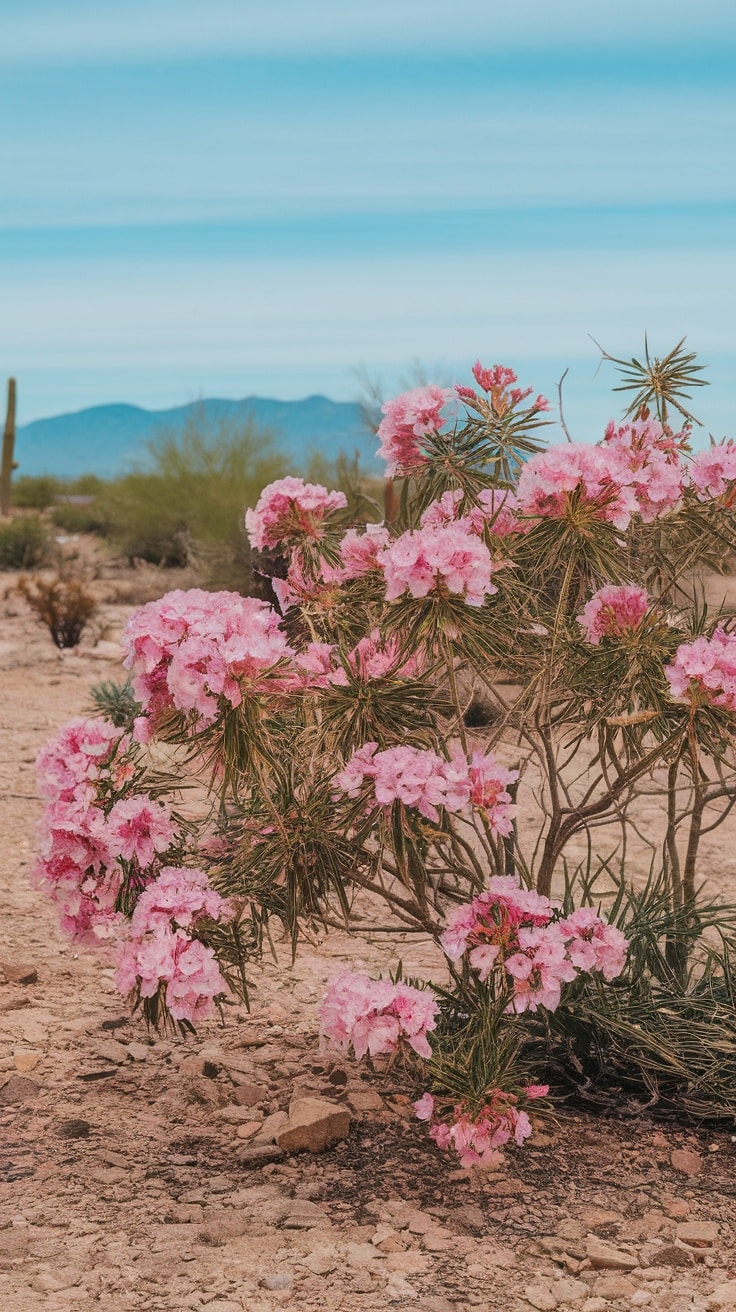
Nerium oleander, commonly known as oleander, is a beautiful addition to any dry garden. Its vibrant pink flowers bring a pop of color to arid landscapes. The plant thrives in warm climates and is known for its ability to withstand drought.
In the image, you can see oleander in full bloom, showcasing its delicate pink petals against a backdrop of rocky terrain. This makes it an ideal choice for gardens that may not receive much water. The narrow, pointed leaves add an interesting texture, complementing the bright flowers.
Oleander is not only visually appealing but also relatively easy to care for. It prefers well-drained soil and should be planted in a sunny spot. Once established, it can tolerate long periods without water, making it a low-maintenance option for gardeners looking to create a beautiful yet resilient landscape.
Ornamental Grasses – Festuca glauca
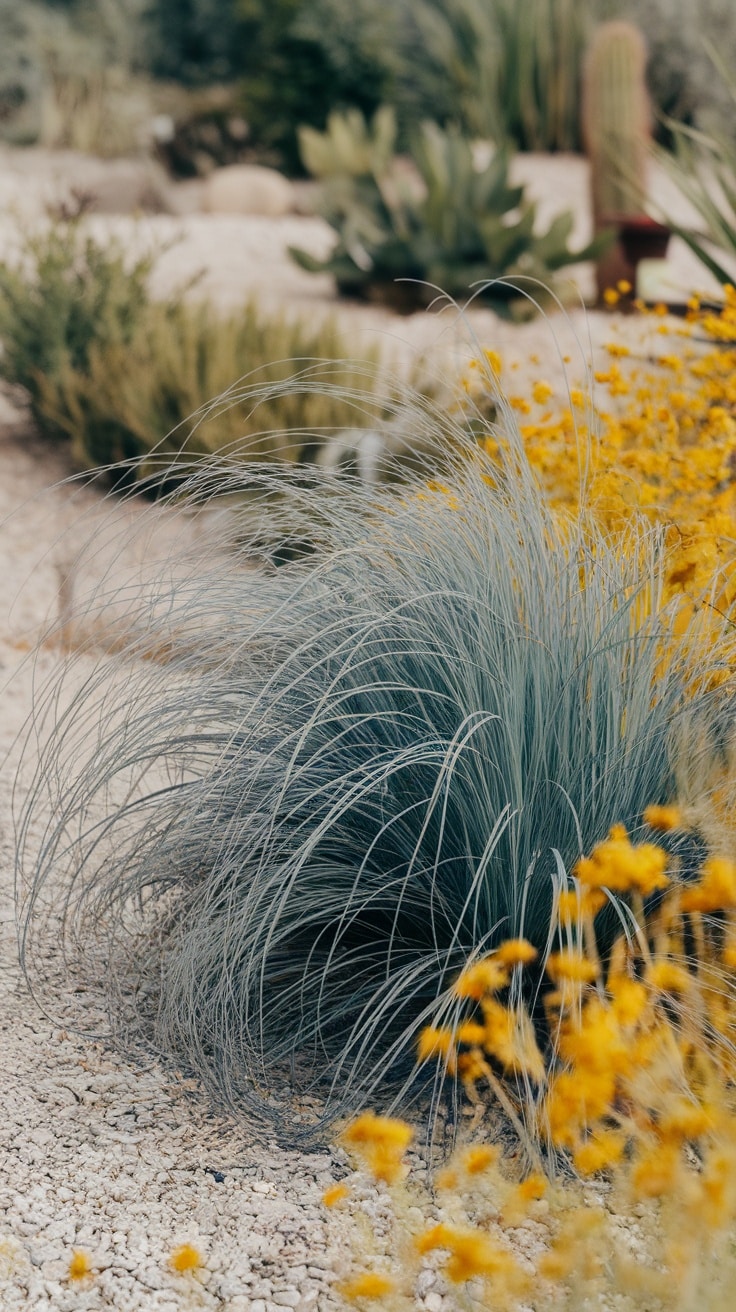
Festuca glauca, commonly known as blue fescue, is a charming addition to any dry garden. This ornamental grass stands out with its striking blue-green hue, creating a lovely contrast against the earthy tones of the garden bed.
The fine, arching blades provide a soft texture that can soften hardscapes. Whether planted in clusters or as solitary specimens, these grasses bring a graceful movement to the landscape, especially when swayed by a gentle breeze.
One of the best features of Festuca glauca is its low water needs. Once established, it thrives in poor, dry soils with minimal maintenance. This makes it an ideal choice for gardeners looking to conserve water while still enjoying a vibrant display.
When paired with yellow flowering plants, as seen in the image, the combination creates a visually appealing scene. The bright blooms pop against the cooler tones of the grass, making the garden feel lively and inviting.
Cacti Varieties – Saguaro Cactus
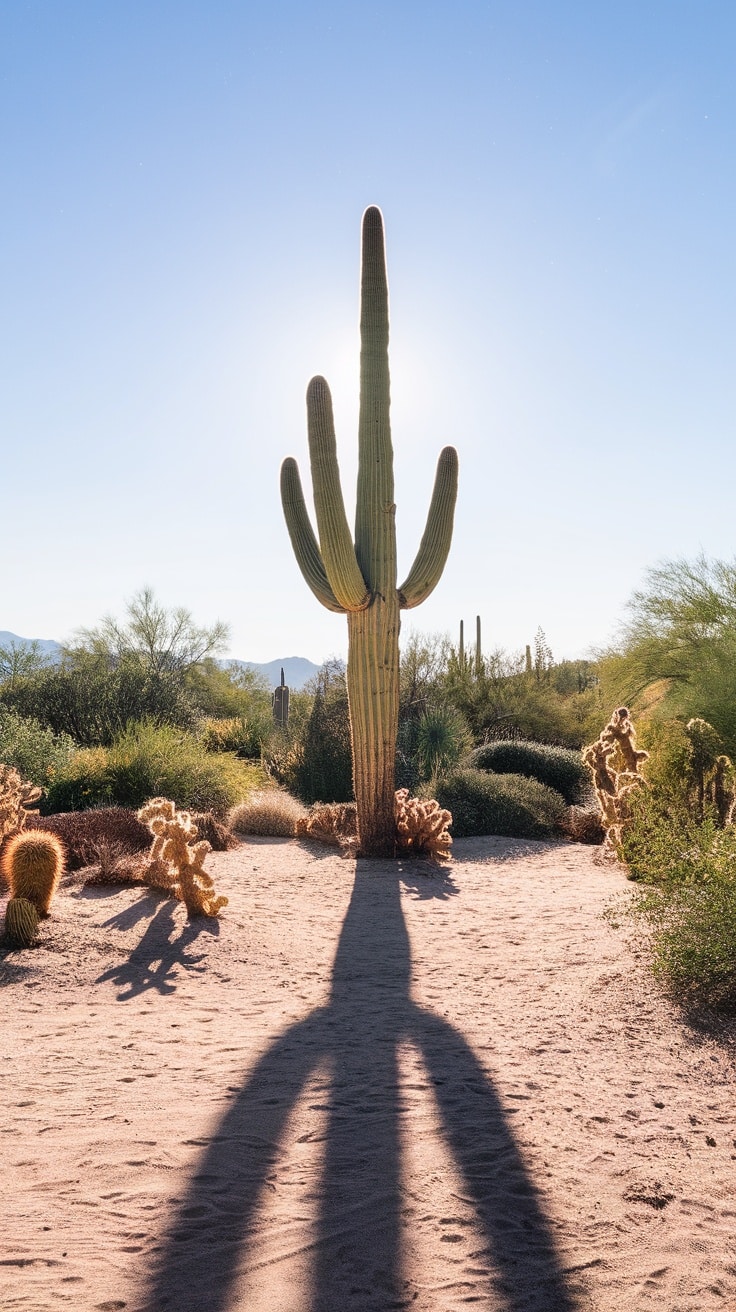
The Saguaro cactus is an iconic symbol of the American Southwest. Standing tall and proud against the blue sky, these giants can grow to be quite large, reaching heights of up to 40 feet. Their unique shape, with tall arms reaching skyward, makes them a striking addition to any dry garden.
In the image, you can see a majestic Saguaro cactus casting an impressive shadow on the sandy ground. This shadow adds depth and character to the landscape, showing just how large and imposing this plant is. Surrounding it are other desert plants, creating a diverse ecosystem that thrives in low-water conditions.
One of the best things about the Saguaro is its ability to store water. During the rainy season, it soaks up as much moisture as it can, allowing it to survive long dry spells. This makes it an excellent choice for gardens in arid regions, as it requires minimal watering once established.
Additionally, the Saguaro provides habitat and food for various wildlife. Birds, bats, and insects rely on these cacti for shelter and sustenance, making them an essential part of the desert ecosystem. Their beautiful white flowers, which bloom during the spring, attract pollinators, adding even more life to the area.
In short, if you’re looking to transform your dry garden, the Saguaro cactus is a fantastic option. Its unique appearance and low maintenance needs make it a standout choice for anyone looking to bring a bit of desert charm into their outdoor space.
Rosmarinus officinalis – Rosemary
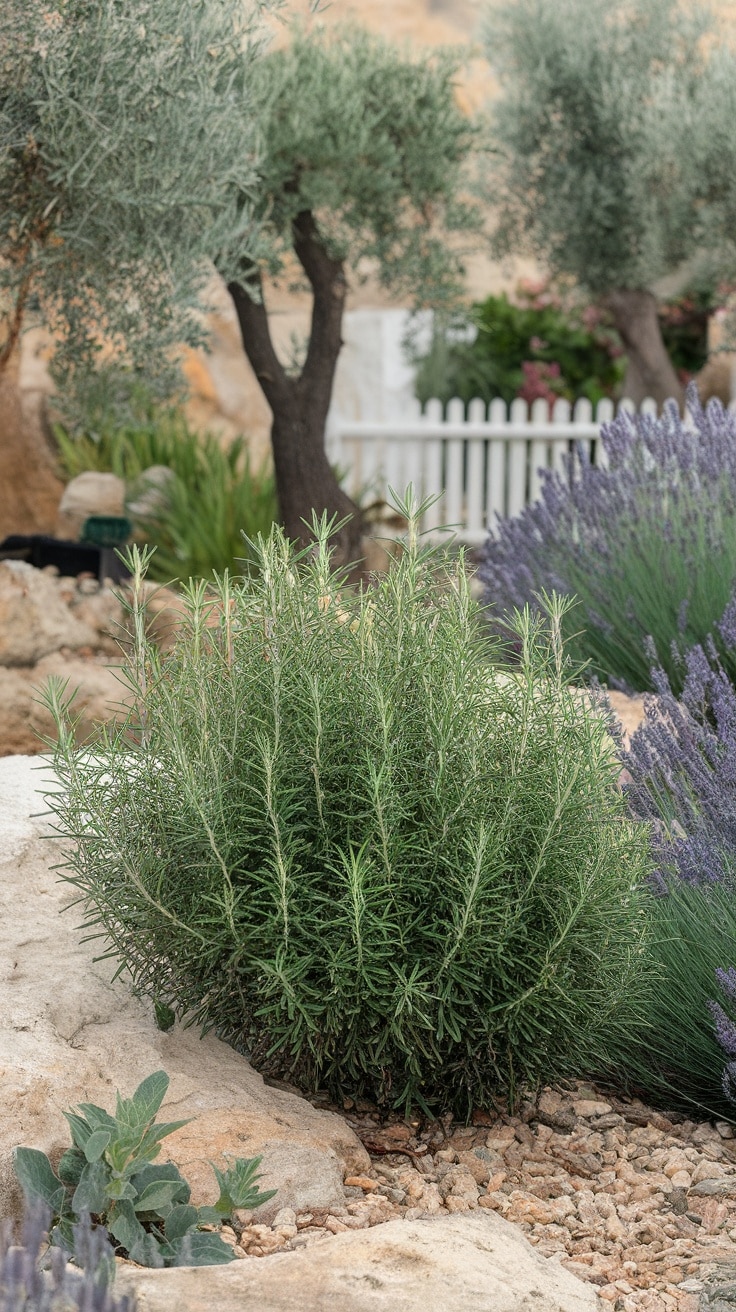
When it comes to low-water plants, rosemary stands out for its versatility and charm. This hardy herb not only adds flavor to your dishes but also enhances your garden’s visual appeal. In the image, you can see a bushy rosemary plant surrounded by textured rocks and other greenery, creating a beautiful natural landscape.
Rosemary thrives in dry conditions, making it a perfect choice for gardens that need to conserve water. Its needle-like leaves are aromatic and can add a wonderful fragrance to your outdoor space. You can plant it in well-drained soil and let it bask in the sun—just make sure it has enough room to spread out.
Caring for rosemary is fairly simple. This plant prefers infrequent watering once established, which means less work for you. You can also prune it for a more compact shape, and it will reward you with a lush, green appearance. Plus, rosemary is a magnet for pollinators, helping to support local wildlife.
As a bonus, you can enjoy its culinary uses. Fresh rosemary can elevate your roasted meats, veggies, and even breads. So, whether you want to boost your garden’s aesthetics or whip up a delicious meal, rosemary is a smart addition.

